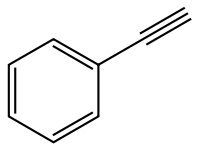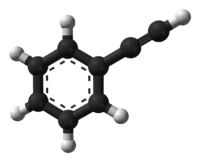Phenylacetylene
 | |
 | |
| Names | |
|---|---|
| IUPAC name
Ethynylbenzene | |
| Identifiers | |
| 536-74-3 | |
| ChEMBL | ChEMBL234833 |
| ChemSpider | 10364 |
| |
| Jmol-3D images | Image |
| PubChem | 10821 |
| |
| Properties | |
| C8H6 | |
| Molar mass | 102.133 g/mol |
| Density | 0.93 g/cm3 |
| Melting point | −45 °C (−49 °F; 228 K) |
| Boiling point | 142 to 144 °C (288 to 291 °F; 415 to 417 K) |
| Acidity (pKa) | 28.8 |
| Except where noted otherwise, data is given for materials in their standard state (at 25 °C (77 °F), 100 kPa) | |
| | |
| Infobox references | |
Phenylacetylene is an alkyne hydrocarbon containing a phenyl group. It exists as a colorless, viscous liquid. In research, it is sometimes used as an analog for acetylene; being a liquid, it is easier to handle than acetylene gas.
Preparation
In the laboratory, phenylacetylene can be prepared by elimination of hydrogen bromide from styrene dibromide using sodium amide in ammonia:[1]
It can also be prepared by the elimination of hydrogen bromide from bromostyrene using molten potassium hydroxide.[2]
Reactions
- Phenylacetylene can be reduced (hydrogenated) by hydrogen over Lindlar catalyst to give styrene.
- It undergoes a metal catalyzed trimerization to give 1,2,4- (97%) and 1,3,5-triphenylbenzene:[3]
- It undergoes a hydration reaction, catalyzed by gold(III) or mercury(II), to give acetophenone.
See also
References
- ↑ Kenneth N. Campbell and Barbara K. Campbell (1963). "Phenylacetylene". Org. Synth.; Coll. Vol. 4, p. 763
- ↑ John C. Hessler (1941). "Phenylacetylene". Org. Synth.; Coll. Vol. 1, p. 438
- ↑ Gerhard Hilt , Thomas Vogler, Wilfried Hess, Fabrizio Galbiati (2005). "A simple cobalt catalyst system for the efficient and regioselective cyclotrimerisation of alkynes". Chemical Communications 2005 (11): 1474–1475. doi:10.1039/b417832g. PMID 15756340.

